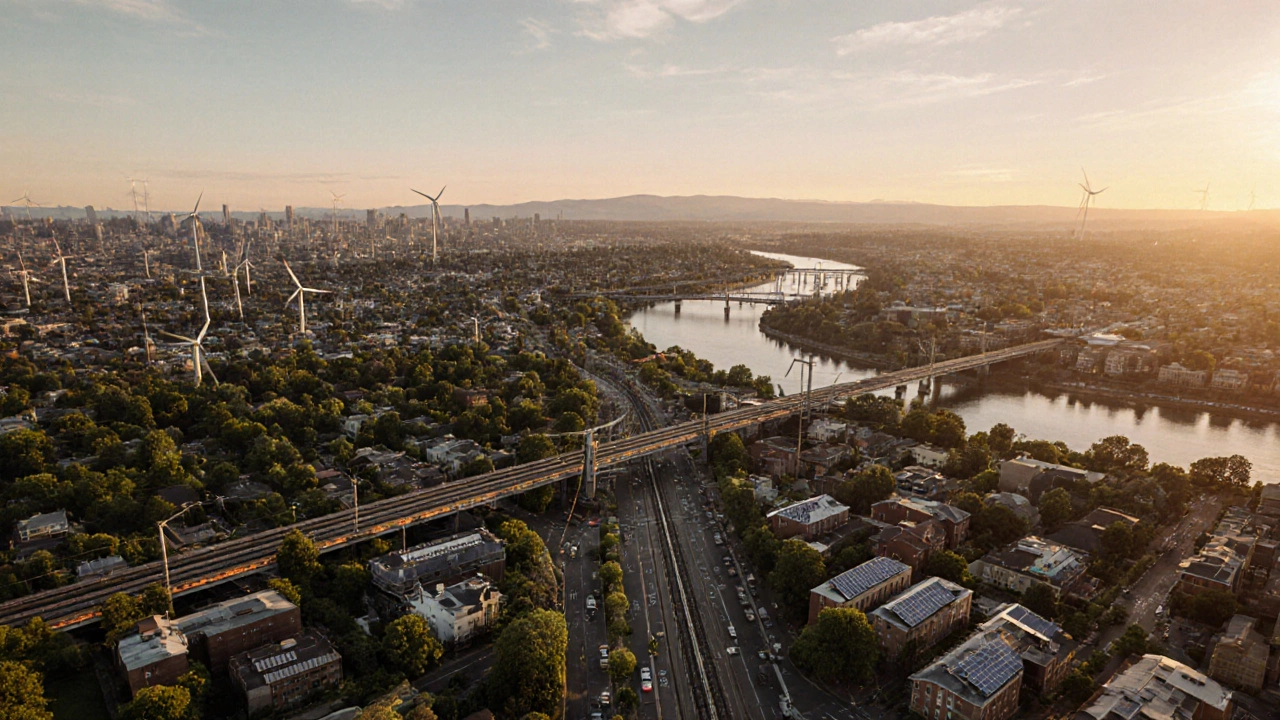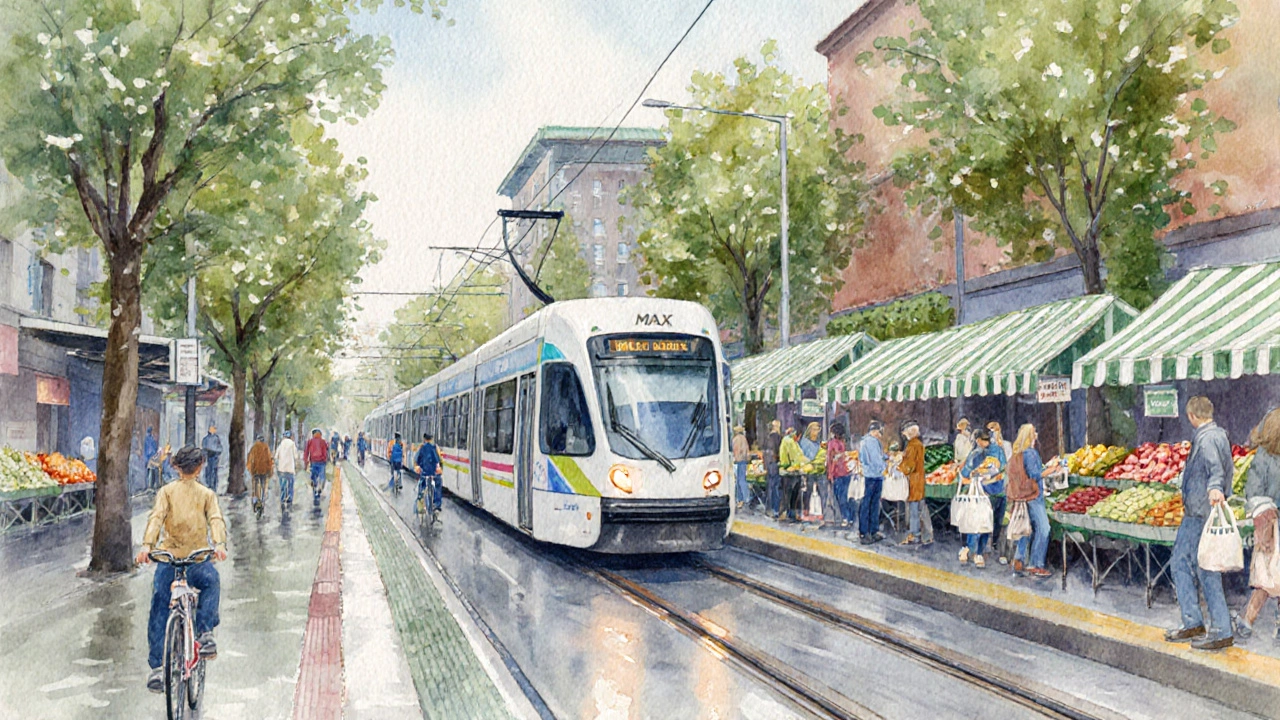Which U.S. City Leads in Eco-Friendliness?
 Oct, 24 2025
Oct, 24 2025
Eco-Friendly City Score Calculator
Calculate Your City's Sustainability Score
Enter your city's metrics to see how it compares to top eco-friendly cities.
Results
Enter your city's metrics to see the results.
Top Cities for Reference
When you ask yourself, "What is the most eco-friendly city in America?" you’re really hunting for a place where clean energy, bike lanes, recycling, and green spaces blend into daily life. Below is a straight‑forward look at how experts rank U.S. cities on sustainability and why one city keeps edging ahead.
Portland, Oregon is a mid‑size Pacific Northwest city that has built its reputation on progressive zoning, extensive public transit, and a zero‑waste ambition. The city’s green‑policy framework makes it a natural benchmark for any eco‑friendly ranking.
How We Measure Eco‑Friendliness
- Renewable Energy Share: Percentage of total electricity generated from wind, solar, hydro, or geothermal sources.
- Public Transit Score: Composite rating from the American Public Transportation Association that combines coverage, frequency, and ridership.
- Green Space per Capita: Acres of parkland, community gardens, and protected natural areas divided by the city’s population.
- Recycling & Composting Rate: Portion of municipal solid waste that is diverted from landfills.
- Air Quality Index (AQI): Average annual fine‑particle (PM2.5) concentration measured by the EPA.
Data comes from the U.S. Environmental Protection Agency, the U.S. Green Building Council, and city sustainability reports released in 2024‑2025. By weighting each metric equally, we avoid favoring any single policy while still rewarding balanced performance.
Top Contenders
Portland, Oregon
Portland’s utility companies source roughly 45 % of electricity from wind and hydro. The city’s MAX light‑rail and bus rapid transit network handles 25 % of commuter trips, and cyclists enjoy over 350 mi of protected lanes. With about 1.5 acres of green space per 1,000 residents, the city feels like a forest inside an urban grid. The recycling program recovers 70 % of waste, and the average AQI hovers at a healthy 28.
Burlington, Vermont
Burlington runs on 100 % renewable electricity-almost entirely hydro‑electric power from the nearby Lake Champlain system. Despite its small size, the city boasts a 15‑minute walkability rating and a public bike‑share that covers the downtown core. Green space per capita tops 2 acres, and the local composting initiative processes 80 % of organic waste. Burlington’s AQI is consistently under 20, making it one of the cleanest air markets in the nation.
Seattle, Washington
Seattle’s commitment to clean energy shows in its 55 % renewable electricity mix, driven by hydropower and expanding offshore wind farms. The city’s Sound Transit system connects suburbs to downtown with a 30‑minute average commute time. With 1.3 acres of parkland per 1,000 people, Seattle also leads in urban forestry programs that plant 10,000 new trees each year. Recycling rates sit at 64 % and the AQI averages 30.

San Francisco, California
San Francisco’s Zero‑Waste Goal aims to divert 100 % of waste from landfills by 2030. Currently, 62 % of the city’s trash is recycled or composted. The MUNI system, supplemented by Caltrain, provides extensive coverage, while a network of bike lanes encourages non‑motorized travel. Renewable electricity accounts for 38 % of the grid, and the city protects 1.2 acres of green space per 1,000 residents. AQI remains under 35 on average.
Madison, Wisconsin
Madison’s lakeside setting fuels a strong biking culture-over 250 mi of paved trails link neighborhoods to the university. The city’s utility purchases 40 % of power from wind farms in the Midwest. Municipal composting processes 75 % of organic waste, and the city’s recycling rate reaches 68 %. With 1.6 acres of parkland per 1,000 people, Madison feels spacious even in winter, and AQI stays around 25.
Austin, Texas
Austin’s “green belt” initiative preserves over 3,000 acres of native habitat within city limits. Renewable energy constitutes 32 % of the city’s power mix, bolstered by a fast‑growing solar market. The Capital MetroRail and bus system serves 18 % of commuters, while new bike lanes add 120 mi of protected routes annually. Recycling is at 62 % and the city’s average AQI hovers at 40, still better than many larger metros.
Why Portland Still Takes the Lead
All the cities above score high, but Portland edges out the competition by balancing every metric. Its renewable energy share is among the top tier, public‑transit usage is high for a city of its size, and its recycling program is both ambitious and widely adopted. Moreover, Portland’s city council continually revises its Climate Action Plan, setting a 2035 carbon‑neutral target. That mix of policy, community buy‑in, and measurable outcomes makes Portland the most well‑rounded eco‑friendly city in America today.
Quick Comparison Table
| City | Renewable Energy % | Public Transit Score (out of 100) | Green Space per 1,000 residents (acres) | Recycle/Compost Rate % | Average AQI |
|---|---|---|---|---|---|
| Portland, OR | 45 | 70 | 1.5 | 70 | 28 |
| Burlington, VT | 100 | 65 | 2.0 | 80 | 20 |
| Seattle, WA | 55 | 68 | 1.3 | 64 | 30 |
| San Francisco, CA | 38 | 72 | 1.2 | 62 | 35 |
| Madison, WI | 40 | 66 | 1.6 | 68 | 25 |
| Austin, TX | 32 | 58 | 1.4 | 62 | 40 |
What Makes a City Truly Green?
Beyond numbers, a city earns its green badge when sustainability is woven into everyday habits. Look for these signs:
- Local food markets and farm‑to‑table restaurants that cut transportation emissions.
- Community‑run compost hubs where residents can drop kitchen scraps.
- City‑wide incentives for solar panel installation on homes and businesses.
- Robust education programs that teach kids about recycling, water conservation, and climate science.
- Transparent reporting-city dashboards that publish real‑time energy use, emissions, and waste diversion stats.
When these pieces click, you’ll notice cleaner streets, fresher air, and a vibe that encourages you to bike instead of drive.
How to Experience Eco‑Friendly Living on a Visit
- Rent a certified green lodging. Look for LEED‑registered hotels or eco‑cottage rentals that use solar hot water and low‑flow fixtures.
- Take public transit or a bike share. Most top cities have mobile apps that let you rent a bike by the hour and track bus arrivals in real time.
- Eat at farmers’ markets. Buying produce that traveled less than 100 miles reduces your carbon footprint while supporting local growers.
- Participate in a community clean‑up. Many cities host weekend events where visitors can help collect litter in parks or along rivers.
- Use reusable gear. Pack a metal water bottle, cloth tote, and a set of bamboo utensils to avoid single‑use plastics.
These small actions amplify the city’s green momentum and give you a taste of life in a low‑impact urban environment.
Frequently Asked Questions
Why isn’t New York City on the list?
New York scores high on transit but lags in renewable energy share and per‑capita green space. Its dense built‑up environment makes it harder to achieve balanced scores across all metrics.
Can a city improve its ranking quickly?
Yes, targeted policies like mandating solar panels on new construction or expanding bike lanes can boost scores within a few years. However, shifting an entire energy grid takes longer.
Do these rankings consider cost of living?
Cost of living isn’t a direct metric, but higher sustainability often correlates with higher housing prices. That’s why it’s worth checking affordability alongside eco‑scores.
Is Portland’s climate a factor in its green share?
Mild, rainy weather makes wind and hydro power efficient, but the city still invests heavily in solar and energy‑efficiency programs to offset seasonal limitations.
How reliable are the data sources?
All figures are drawn from EPA’s Air Quality System, the U.S. Green Building Council’s annual reports, and each city’s 2024‑2025 sustainability dashboards, which are audited by third‑party agencies.